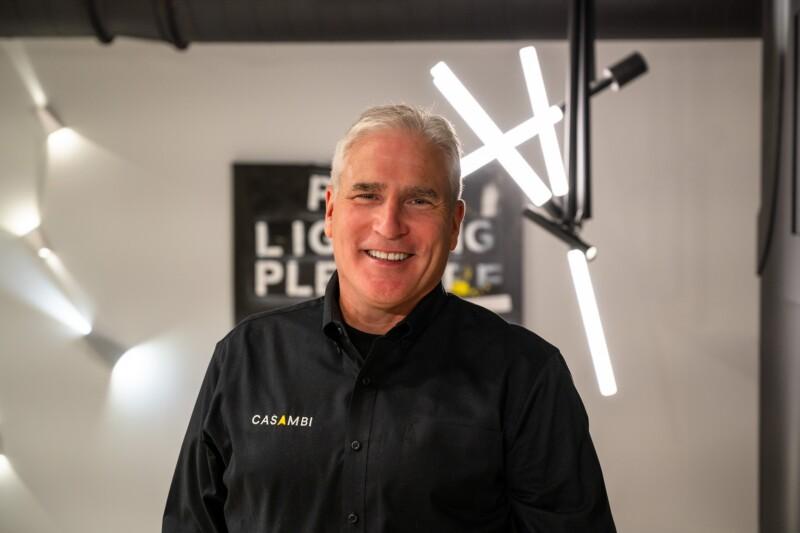Good light is a universal need.

The way we’re illuminating the world needs to change. We have a window of opportunity right now to evolve or risk reverting to old, suboptimal ways.
Governments are enacting measures to ensure that LEDs are used in residential, public, and industrial spaces. This is great because they’re proven to save up to 70% of energy consumption and the related, indirect CO2 emissions. And by taking fluorescent light sources off the market, we’re phasing out the use of toxic materials, such as mercury and phosphorus.
LED lights include a semiconductor to produce light and this component opens the doors to wireless lighting control – the transformative potential of which is huge. The LED penetration rate of the worldwide lighting market currently sits somewhere just above the 50% mark. We have a perfect window of opportunity right now to convert users of artificial light (ie. Everyone!) to wireless control use. If we fail, there’s a risk that the market will revert back to the old ways, and nothing evolves.
We can’t afford to miss this opportunity.
Science says bad lighting can affect our health. It’s exhausting to live and work in, and its excessive use not only causes energy waste but adversely affects biodiversity through light pollution. The uptake of digitized LEDs, the mainstream acceptance of wireless technology, and software-driven programming can move us on from primitive on/off and dimming control by enabling sophisticated fine-tuning; controls to harness the healing power of light. We can provide only the right light, in the right place, at the right time. Now we need to get this into every home, hospital, school, public building and place of work the world over.
Good light will shape the coming century.
By going wireless we use 40% less copper wiring. And we can introduce customizable, flexible light-level management – the ability to remotely precision-tweak the color, the color temp, the quantity, and the time duration of exposure to certain lights. This digitalization also enables the augmentation of energy and data services through lighting. Energy shaving through optimized use, operational transparency and predictive maintenance through the provision of alerts for anomaly detection and malfunction. All further supporting the drive to achieve sustainability and efficiency goals.
Casambi: Complex made easy.
Our Bluetooth Low Energy-based mesh technology wirelessly links devices together. It’s fast and easy to install and operate, interoperable and scalable. Essentially luminaires, switches and sensors gain Casambi connectivity by either incorporating our chips or by using our external Bluetooth modules. Minimal hardware is required. No cables, no internet, no routers are needed to run a network.
All you need to do is to power up the product, then program and engage with the lighting using the Casambi App on a smart device. Casambi Ready switches and sensors with wireless mesh functionality also increase the interaction options.
Psst….wondering what a mesh network is? Mesh networking is essentially a low-latency, low-power mesh network protocol, which in layman’s terms translates to a super-fast, battery-life-extending, and highly reliable connection. Mesh networks are self-healing too. If one smart device in the network suddenly becomes unavailable, in a mesh network data is automatically rerouted to prevent a connection drop. The larger the lighting network, the stronger the mesh.
With Casambi you can;
- Install lighting without extensive construction and set it up remotely from the app – reducing embodied and operational carbon.
- Perpetually and simultaneously change and control environments across multiple locations: Rewiring is done in the software.
- Reduce energy consumption: From occupancy detection to scheduling, to daylight harvesting, automated lighting strategies can be programmed and implemented.
- Improve safety and well-being: Lighting can be adjusted in real-time to the optimal level for individual needs.
- Provide a transparent network infrastructure that can easily scale up with minimal disruption and expand to outdoor applications. With additional wireless connectivity and two-way communication, lighting can become a scalable IoT canopy that offers a multitude of other solutions beyond illumination too.
- Enjoy scale and choice: We collaborate with all the prominent global luminaire, driver, LED board, LED lamp, and lighting control module manufacturers – to offer the most comprehensive ecosystem for wireless lighting controls. They bring their own unique designs to the table, yet the chips and the firmware inside all devices come from Casambi. This guarantees interoperability.
We’re on a journey. Together.
We started developing Casambi before there were any Bluetooth Low Energy devices on the market. Growth forecasts now predict that 96% of all Bluetooth-enabled devices will include Bluetooth Low Energy by 2025 and six billion Bluetooth-enabled devices will ship annually by the same year – we bet on the right technology.
We’ve created a solution that is quick and easy to incorporate and updateable via over-the-air programming. Our main competitor is old thinking and ways of working… wired lighting control installations. Light is central to life, and yet it remains one of the last mainstays of the traditional wired world – we’re changing this and have galvanized a movement together with leading luminaire and component manufacturers.
At Casambi, we master the tech behind the scenes. But it’s the leading technology and manufacturing companies who bring great products to market, creating the momentum to push us all forward in the right direction.
And we’re on to something wonderful.
To date, over 4 million Casambi Ready devices have been sold worldwide. Casambi’s been specified in over 150,000 projects, spanning every application from small high-end residential to 10,000+ node industrial spaces. We are considered the de facto standard in Europe. And we have established regional headquarters in North America and APAC regions to serve our global networks. Casambi is deployed in highly sensitive environments, such as in hospitals and airport control towers. Our system is robust in design and has been certified as cyber-secure in accordance with global standards.
We’ve heard that real estate owners and facilities managers save an additional 40% on industrial warehouse lighting bills after adding Casambi wireless controls and sensors to LED fixtures.
Monumental historical sites are benefiting too. The Panathenaic Stadium (birthplace of the Olympics) reduced light pollution by 70% after installing Casambi control. And we managed to install and commission 15,000 Casambi-controlled LEDs across nine of the BBC’s UK sites without interrupting their critical 24/7 broadcasting operations.
But it’s a big world out there.
If we look at India – the seventh largest country in the world by area. India launched the world’s largest zero-subsidy LED bulb program (UJALA) with a target of replacing 770 million incandescent lamps with LED bulbs. And their Street Lighting National Programme (SLNP) aims to replace conventional streetlights with smart and energy-efficient LED streetlights. This is the largest LED street-lighting program in the world. India’s power minister RK Singh described these programs as driving “large-scale socio-economic transformation”.
By incorporating wireless control, India’s LED program could further drive down costs, increase productivity, enhance safety, and improve the well-being of humanity and the environment. With Casambi, pre-existing wired installations could be easily expanded wirelessly and upgraded to include occupancy and daylight sensors too. We have the infrastructure in place to support Indian luminaire and component manufacturers wishing to incorporate Casambi functionality. Casambi systems can also be maintained remotely to reduce travel and related financial and environmental cost implications thereof.
There is no one-size-fits-all solution for providing better lighting – schools require different lighting to hospitals and factories different lighting to streets. But we can provide the freedom to adjust lighting to levels that will help deliver the large-scale socio-economic transformation the Power Minister spoke of.


